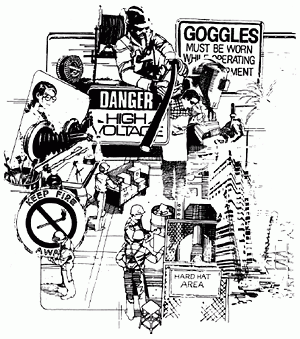What Is A Common Hazard In Wearing Ppe?

Personal protective equipment (PPE) refers to equipment that people wear to minimize their exposure to dangers. For example, employees who work with caustic chemicals should wear gloves and goggles to protect their skin and eyes. PPE may also include helmets or hard hats, safety shoes, protective clothing and hearing protection. PPE can save lives, but if a program is implemented improperly, it can keep workers at risk and expose them to additional dangers.
False Sense of Security
Wearing PPE often gives workers a false sense of security, which can be deadly. PPE does not completely protect workers from hazards, such as chemicals, electricity and sharp objects. However, workers who believe PPE will completely protect them from hazards may be less attentive to other safety measures, such as environmental controls, or may be more careless with safety precautions.
When PPE Creates Hazards
PPE isn't one-size-fits-all. PPE systems must be individually designed for each job. Wearing the wrong type of protection can place a worker in more danger, rather than protecting her. For example, thick chemical-resistant gloves may protect a laboratory scientist from chemical burns, but they will impair the grip and dexterity of a worker using a drill press or lathe, causing an entanglement hazard.
Pre-Contact vs. Point-of-Contact
PPE protects workers during point-of-contact hazards, such as exposure to ultraviolet light or contact with a caustic acid. Effective PPE improves worker safety by reducing the risk of injury, but it doesn't eliminate the hazard. Pre-contact controls--such as obtaining safer equipment or eliminating a hazardous process--are essential to improving worker safety, because they eliminate hazards completely.
Using PPE Effectively
An effective PPE program should be planned carefully and introduced in stages. Employers should explain the benefits of PPE to employees and give them time to become used to new requirements. For best results, provide comfortable and attractive protective equipment, ensure equipment fits all employees and give employees choices among different types or styles of equipment. Teach employees how to maintain PPE, inspect PPE regularly and conduct annual audits of the program for compliance and effectiveness.
False Sense of Security
Wearing PPE often gives workers a false sense of security, which can be deadly. PPE does not completely protect workers from hazards, such as chemicals, electricity and sharp objects. However, workers who believe PPE will completely protect them from hazards may be less attentive to other safety measures, such as environmental controls, or may be more careless with safety precautions.
When PPE Creates Hazards
PPE isn't one-size-fits-all. PPE systems must be individually designed for each job. Wearing the wrong type of protection can place a worker in more danger, rather than protecting her. For example, thick chemical-resistant gloves may protect a laboratory scientist from chemical burns, but they will impair the grip and dexterity of a worker using a drill press or lathe, causing an entanglement hazard.
Pre-Contact vs. Point-of-Contact
PPE protects workers during point-of-contact hazards, such as exposure to ultraviolet light or contact with a caustic acid. Effective PPE improves worker safety by reducing the risk of injury, but it doesn't eliminate the hazard. Pre-contact controls--such as obtaining safer equipment or eliminating a hazardous process--are essential to improving worker safety, because they eliminate hazards completely.
Using PPE Effectively
An effective PPE program should be planned carefully and introduced in stages. Employers should explain the benefits of PPE to employees and give them time to become used to new requirements. For best results, provide comfortable and attractive protective equipment, ensure equipment fits all employees and give employees choices among different types or styles of equipment. Teach employees how to maintain PPE, inspect PPE regularly and conduct annual audits of the program for compliance and effectiveness.
- 8j06eb9fa708ef282060f462488eb2071a.jpg
References
http://www.ehow.com/facts_7517803_required-ppe-custodian.html
http://www.ehow.com/info_7791877_common-hazard-wearing-ppe.html